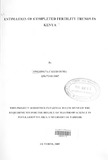| dc.description.abstract | This study set out to adopt the use of Parity Progression Ratio (PPR) to estimate Completed Fertility using the fertility table model. The conventional age-based measure of fertility (ASFR) and their sum over all ages, the total fertility rate (TFR) which is a proxy measure of fertility indicate that Kenya's fertility has stalled (Bongarts, 2005). The study examines what the situation would be if the measure of actual fertility preferences are considered.
The specific objectives of the study are to estimate the completed fertility levels and trends in Kenya based on the life table approach and to examine the differentials in completed fertility by type of place of residence and education level. The study adopted the model of estimating completed fertility as developed by Feichtinger and Lutz (1983). The measure is only applied to women at the end of their child bearing years (40-49). The study uses data from the KDHS 1989-2003 series.
The result indicates that fertility in Kenya continues to decline despite earlier indication by the conventional method that it has stalled. However, the study presents a stalled fertility in urban area. By level of education, the stall is most evident among the least educated while those with secondary or higher education still shows a modest decline. The policy implications to the government and relevant stakeholders to formulate policies design and implement appropriate strategies that are geared towards fertility reduction.
The programs set should be implemented with recognition that there are regional variations especially in the rural areas. Secondly, there is need to improve and encourage education of the women as it changes the ideas and attitude towards early childbearing. Efforts should be made to encourage girls to have secondary and above education especially in rural areas.
The study further recommends that further studies focusing on fertility tables using other sources of data such as census data for comparability purpose. Detailed qualitative studies should be undertaken to establish factors that contribute to fertility variations and other approaches used in estimating fertility be applied to Kenya data and be compared to the conventional TFR . | en_US |

